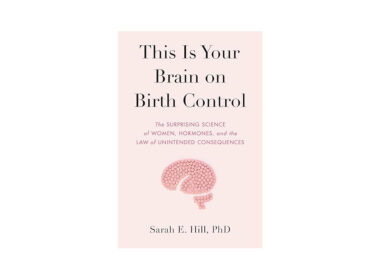Pregnancy can sometimes feel like a tightrope between very high-stakes “do’s” and “don’ts.”
Do drink raspberry leaf tea every day to ensure a shorter easier labor BUT не drink it in the first trimester or you could cause miscarriage! Do make sure to eat lots of omega-rich food like fish BUT не have too much fish or you could expose the baby to too much mercury!
See what I mean?
Even 20 weeks into my second pregnancy, my Google search history is a long list of “should a pregnant woman…. Drink kombucha? Take melatonin? Do sit ups?”
Many of my Google searches turn up a red blinking sign saying pregnant women should не do that thing, but often there isn’t a clear answer why.
As a psychologist, I know scientists avoid non-essential testing of medicine, products, supplements, etc. on pregnant women, and the general advice to pregnant women is that they just shouldn’t use anything untested. The placental barrier between mother and baby is permeable, and at various stages of in utero development, some substances that are not detrimental to a person out of utero можно lead to physical deformities, learning deficits, или выкидыш.
Pain meds during pregnancy can be controversial, and many women seek other options
One of my more frustrating Google searches has been for pain relief in pregnancy. Many pain medications are not considered safe for pregnant women, and the few that are can still be controversial. However, this doesn’t mean pregnant women are doomed to 9 months of discomfort. If you’re experiencing some kind of pregnancy-related pain, you might consider trying one (or a combination) of the following non-pharmaceutical pregnancy pain relief options.
Option #1: Change your mindset
Have you tried thinking away your pain? I know it sounds crazy, but the mind is a powerful tool. Changing your perspective on your pain could be enough to decrease your discomfort, if not remove it altogether.
Prominent psychologist Ellen Langer has spent her career demonstrating the power the mind has over physical experiences. Недавнее исследование went so far as to prove that wounds heal faster when a person is led to believe that time is moving faster than it really is [1].
Some of Dr. Langer’s предыдущие исследования points to mindfulness—a form of practiced focus that brings one more in tune with their body in the present moment—as a way to improve birth outcomes for mother and baby [2]. Though this study did not directly address pain relief in pregnancy, women in the test group reported greater life satisfaction, which tends to be related to less pain and discomfort.
Practicing mindful awareness
You can practice mindfulness by taking notice of changes in your feelings and physical sensations in the moment. Take a moment to sit and actually focus on your experience of pain. Isolate its location, focus on remaining relaxed, and knead the pain with your mind. Mindfulness can be used to decrease pain by identifying the exact source of the pain and noticing how it can change.
Some alternative thought exercises include picturing the pain shrinking to a smaller and smaller radius, or decreasing in intensity the way one can turn down the volume on a radio. When you feel ready, move on to something that will not reactivate the pain, and check back in with yourself in an hour. You might be shocked to discover just how powerful the mind can be!
Option #2: Distract yourself
The previous pain relief method recommends focusing on the pain, but that is just one step in the journey to moving beyond pain. An alternative form of pain relief also taps the power of the mind but in the opposite way—a lack of focus through good old-fashioned distraction.
You might roll your eyes at this, but depending on the cause and intensity of pain, distraction can be more powerful than you think. You already know this from scrolling on Instagram, but I’m referring to something a little different.
Specifically, engaging in a high-attention activity can redirect your mind’s attention away from your pain, essentially causing you to forget that you are in pain [3]. The activity should be stimulating for your mind, and —depending on your kind of pain—should be a little active and stimulate your body, too (that’s why Instagram scrolling doesn’t count!). Try tackling some light chores, making cookies, or playing a board game with your family. This might not make your pain go away, but it will hopefully make it more manageable for at least a little while.
Option #3: Hot and cold therapy
Applying heat or cold to a sensitive or inflamed area can provide much needed pregnancy pain relief. Many midwives or doctors will recommend or use hot and cold therapy during labor, but this treatment can be used before birth as well.
Pregnant women release relaxin, a hormone that loosens ligaments in preparation for labor. Sometimes this can result in soreness or injury, especially after exercise. Muscle or ligament pain can be relieved by treating the inflammation or increasing blood flow to the area through hot and cold therapy.
But which should you use: a warm compress or a cold pack? You can experiment to see what works best for you, but in general, tightness and recurring pain is best treated by heat while sharp or sudden pain is best treated by cold. Avoid extreme temperatures by using ice packs (for cold) or microwaved rice packs (for heat) and find a balance that works for you.
Option #4: Massage
Massage has been used for centuries to improve health and wellbeing, and to decrease pain and discomfort. In pregnancy, when women’s bodies are especially susceptible to discomfort from rapid growth and hormone shifts, massage can bring great mental and physical relief.
There are many different kinds of massage to choose from, and some cater specifically to pregnant women’s needs. For example, Swedish massage has particular benefits in pregnancy as it targets many of the circulatory and skeletal changes that come from hormonal shifts in pregnancy. Massage will have different specific benefits depending on the kind chosen, but you may experience a decrease in discomfort, reduced swelling, decreased anxiety, improved circulation, decreased nerve pain, better sleep, and decreased tension.
If you opt for prenatal massage, check that your masseuse is certified in prenatal massage. This means they will know how to position you safely depending on your trimester. You wouldn’t, for instance, lay flat on your belly in your second trimester and beyond!
Option #5: Chiropractic care
What comes to mind when you think of chiropractic care? A resounding, satisfying ‘crack’ of the back or neck? Did you know that хиропрактика can be safely utilized during pregnancy for low back pain as well as pelvic or girdle pain [4]? While all chiropractors are trained to care for pregnant women safely, some have gone above and beyond to achieve additional certifications or designations specific to the prenatal period.
Option #6: Acupuncture and TENS
If you’ve experienced nausea in pregnancy, you have probably heard that акупунктура can help [5]. Acupuncture can also be used to treat other pain symptoms in pregnant women including back pain, pelvic pain and headaches. While acupuncture has its roots in traditional Chinese medicine, within Western medicine it is “believed to stimulate the central nervous system. This releases chemicals into the muscles, spinal cord, and brain. These biochemical changes may stimulate the body’s natural healing abilities. They may promote physical and emotional well-being.”
Outside of pregnancy, acupuncture has been used to treat many sources of pain. Though broad research in pregnancy is lacking, акупунктура is considered a low-risk treatment in pregnancy when administered correctly [6]. Some researchers swear by acupuncture while others say that acupuncture pain relief is little more than a placebo effect. Either way, many people have experienced relief from pain through this treatment and it might be worth giving it a try.
You’ve also got the option of trying a transcutaneous electrical nerve stimulation (TENS) unit at home. While TENS units are sometimes used for pain relief during labor, with proper usage they may work for pregnancy-related back pain, too.
Option #7: Pelvic floor physical therapy
Your pelvic floor takes on a lot of pressure in pregnancy and through labor. Women, especially those who have increased pain from previous births, can find relief from pelvic floor physical therapy for symphysis pubis pain, lower back pain, Sacroiliac (SI) joint pain, or pelvic pain.
Pelvic floor therapy works on strengthening and relaxing your pelvic muscles to support your baby and you, increase bladder control, and prepare for birth. Your physical therapist will likely spend some time working with you on core and hip strengthening as these muscles work closely with your pelvic floor.
Most pregnant women could benefit from increasing attention to their pelvic floor as they near labor. However women who are preparing for multiples, are experiencing pelvic floor pain or have experienced pelvic floor pain before, have bladder leakage, or have had an episiotomy or tearing in previous labors are the strongest candidates for pain relief from pelvic floor therapy.
Finding a pelvic floor PT
To find the right pelvic floor therapist for you, speak with your midwife or OB/GYN about a therapist they recommend. If you are pregnant, but not experiencing pelvic pain currently, consider asking for a recommendation anyway. Pelvic floor therapists are a powerful resource for postpartum recovery. Know, too, that in many states you can self-refer to a pelvic floor PT without waiting for a referral from your provider.
Option #8: Supplements
Unlike ibuprofen, there is not a one-size-fits-all pain solution to be found in the vitamin and supplement aisle. However, it is likely worth your time to look into your specific pain, find a supplement that might decrease your pain symptoms, speak with your doctor before using it, and wait for your body to rebalance and heal.
Many supplements are touted for their pregnancy-related benefits such as raspberry leaf tea for easier labor and evening primrose oil for preparing the cervix for birth. Ginger or peppermint leaf tea can ease morning sickness nausea for some. Riboflavin and CoQ10 are believed to prevent migraines, and исследования have proven these safe for pregnancy.
Other pain relief might be found in supplements used in and out of pregnancy. For example, many women experience leg cramps in pregnancy. Though not a cure-all for everyone, магний can greatly impact muscle and inflammation-related pain. Some women find increasing magnesium intake through food sources is enough to feel relief while others swear by magnesium baths (epsom salt).
Most supplements will have a warning label advising pregnant women to speak with their doctor before use. Check with your midwife or OB/GYN before starting something new.
Always check with your healthcare professional before assuming pregnancy pain is normal
Check in with your midwife or OB/GYN if you’re having consistent pain during pregnancy. Of course, many aches and pains are par for the course during pregnancy, but not all. In rare cases, pain, especially sudden sharp pain on one side of the abdomen, may indicate a serious problem that needs to be addressed right away. For run-of-the-mill discomforts, consider some of the aforementioned non-pharmaceutical pregnancy pain relief options.
Ссылки:
[1] Aungle, P., Langer, E. Physical healing as a function of perceived time. Sci Rep 13, 22432 (2023). https://doi.org/10.1038/s41598-023-50009-3 [2] Zilcha-Mano S, Langer E. Mindful Attention to Variability Intervention and Successful Pregnancy Outcomes. J Clin Psychol. 2016 Sep;72(9):897-907. doi: 10.1002/jclp.22294. Epub 2016 Mar 23. PMID: 27007939. [3] Rischer KM, González-Roldán AM, Montoya P, Gigl S, Anton F, van der Meulen M. Distraction from pain: The role of selective attention and pain catastrophizing. Eur J Pain. 2020 Nov;24(10):1880-1891. doi: 10.1002/ejp.1634. Epub 2020 Aug 13. PMID: 32677265; PMCID: PMC7689692. [4] Conner SN, Trudell AS, Conner CA. Chiropractic Care for the Pregnant Body. Clin Obstet Gynecol. 2021 Sep 1;64(3):602-610. doi: 10.1097/GRF.0000000000000621. PMID: 33882524. [5] Smith C, Crowther C, Beilby J. Acupuncture to treat nausea and vomiting in early pregnancy: a randomized controlled trial. Birth. 2002 Mar;29(1):1-9. doi: 10.1046/j.1523-536x.2002.00149.x. PMID: 11843784.
[6] Park J, Sohn Y, White AR, Lee H. The safety of acupuncture during pregnancy: a systematic review. Acupunct Med. 2014 Jun;32(3):257-66. doi: 10.1136/acupmed-2013-010480. Epub 2014 Feb 19. PMID: 24554789; PMCID: PMC4112450.











